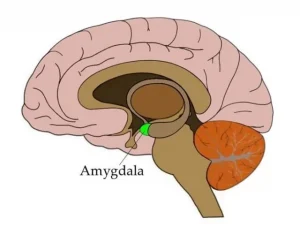
How to Reset Amygdala
Our brain’s Amygdala, a tiny but magnificent superstar, is located deep among its hidden chambers. This fascinating small structure holds the key to revealing the

Aiming to find that sweet spot between bore out and burnout? Stuck between too much work or hardly any work at all?
The curve based on Yerkes-Dodson Law shows the relationship between stress arousal (pressure) and performance. If we study it in detail, we can unveil the ideal zone of peak performance and productivity, which can help us manage stress and unlock holistic well-being in a more organised manner.
The upcoming texts will uncover performance analysis through this management tool.

We have all dealt with the various aspects of stress – the positives and the negatives. But how can stress be positive? And if it is so, can it help in enhancing our productivity?
The pressure-performance curve is the bell-shaped trajectory that accounts for your three productivity zones, i.e., the comfort zone, the good(optimal) zone, and the terror zone.
Traditionally, this curve is referred to as the stress performance curve. But stress has that negative connotation associated with it.
Strictly speaking, stress too can be positive, but the negative reference in the mind of people makes it enigmatic.
The ideal zone, or the good zone, is the “just-right” amount of stress needed to bring out an individual’s optimal productivity levels. But how to achieve this? A thin line at both ends differentiates between the under-stressed and the over-stressed zone.
Let us read about them in detail to find out what sets the three of them apart and how to achieve the right measure of stress for the threshold.
In which zone did you find yourself today?
The left side of the curve, mapped by the light blue colour, shows the low pressure and the low-performance zone.
It’s the stage when the person is bored, unmotivated, and laid back.
Even if the task is of great importance, in the absence of the appropriate pressure for the threshold, the attention and concentration will be low, leading to low productivity levels.
In the under-stressed zone, you are at your comfort level. But can you jump to the next level of your productivity if you stay there? “A comfort zone is a beautiful place, but nothing ever grows there.”
And to achieve growth, you need to apply minimum stress to come out of that comfort zone. But what happens if you don’t?
In the long run, this stage leads to Boreout – the opposite of burnout in workload pressure, but with the same draining effects.
According to a study by the RAND Center for the Study of Aging, nearly 50% of all retirees in the US continue to work part-time or return to work fully after they have retired.
This is to avoid being bored because every human needs a sense of purpose in their life to thrive. The state of having nothing to do at all, and sitting on the couch, Netflixing, and sleeping away is neither good for mental health but also for physical health.
The signs of boreout include demotivation, lethargy, insomnia, anxiety and depression.
Our goal is to apply a little more stress, effort, and motivation to jump out of this zone and enter into the area of optimum productivity.
The right-hand side of the curve, shown by the dark-blue colour, is the one where lies the high pressure. But high pressure does not necessarily mean high productivity levels, in fact the opposite.
The over-stressed zone leaves us feeling overwhelmed, exhausted, anxious, and burnt out due to work. And this is not good either.
This area leads to a zone of delusion, where we might feel that working harder might improve our performance.
Wrong! If boredom is inappropriate, so is over-working. We need to know when and where to stop to maintain the right level of productivity. Because working extra hours continuously might feel like a reward, but it doesn’t add on to the productivity, infact it declines after a certain sublimation.
Companies need to safeguard their employees’ mental and physical health by preventing them from falling over to the right side of the curve.
Managers should intervene and ensure steps are taken to reduce the pressure. To set a good example for their team, they should make sure they take vacations and breaks by themselves.
As an individual, irrespective of what you are doing in life, you should be aware of your limits and when it is getting out of the zone.
The goal here is to know when and where to stop before reaching the extent to which your body and brain could break down.
The middle portion of the curve, that is shown by the orange colour signifies to the ideal zone, has the optimal amount of stress required for an individual to give the best results, and therefore witnesses the best levels of productivity.
This state witnesses a focused and motivated tract, a state of being “in the zone“, where you are productive and give out good results.
This is why this region is also referred to as “the area of best performance”. In other words, this area witnesses moderate pressure resulting in optimum stress, or manageable stress, leading to the highest level of performance.
This is that level of stability in terms of work performance that you achieve after coming over and ahead of your comfort zone, and before reaching the stage of exhaustion.
The goal now is to maintain this level and make it a part of your routine.
Managing the right amount of stress is a hop on the path to achieving your ideal zone.
But how are you planning to do it? Let us discover some ways that make it convenient to be in the orange zone.
The managers should take the responsibility to create a healthy working environment that is competitive but not toxic. Also, an individual should have a social life outside the workplace to motivate them for something to return to and gives them a reason to come back better, with a fresh mind.
Indulging in exercise helps you stay focused in-the-zone, and keeps the health problems at bay.
It has been believed that the higher the position, the greater the stress level. Instead, it has been observed that the leaders with higher levels of responsibility experience lower stress levels than those with less on their shoulders. Therefore the bosses, leaders and seniors should take the proper stress management measures for their subordinates.
Have some work for the future or hope for something positive in the future keeps us thriving and motivates us to leave our comfort zone. Hence, it is a must to have that.
Conforming to the co-workers’ opinions rather than voicing your own, or switching your plan while not being able to express yourself is the primary stress factor, which will leave you anxious, as well as not let you come into your creative/satisfaction zone.
It gives rise to anxiety levels. It is essential to maintain your code of conduct and not tolerate likewise from any other.
The goal is to manage the stress effectively, jump out of your comfort zone, and fend off the stage of exhaustion. The overall intention is to help you manage your stress levels the right way, direct them in the right direction, push your limits, and know when to stop. The purpose is to push you up from your comfort zone and resist the dead-end of the terror zone.
We are rarely either totally stressed or completely relaxed. Extreme to anything is harm! We need to be somewhere in the middle. Our position can be changed daily, weekly, minute-by-minute, or over a while.
Remember: To satisfy your productivity and holistic health, it is crucial to maintain the right balance between good and bad stress, to help you achieve your optimum results.

Our brain’s Amygdala, a tiny but magnificent superstar, is located deep among its hidden chambers. This fascinating small structure holds the key to revealing the
Get a discount in your email!
